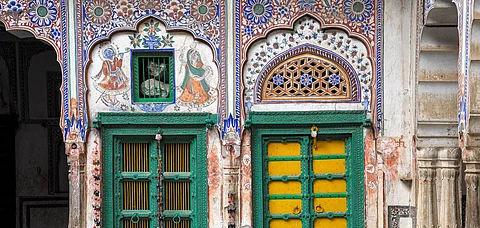

The town of Mandawa in Rajasthan has come a long way since its days as a trading outpost on an ancient caravan route for goods from the Middle East and China but it still remains one of the little known attractions on the tourism map of the state.
But did you know that about 170 km by road from state capital Jaipur, Mandawa can be your springboard into the splendours of Shekhawati, a region known for its splendid painted mansions
It was their business acumen that found the men from Shekhawati entering into trade with the British and settling down in Calcutta (now Kolkata) and Bombay (now Mumbai). Most of them would remit the money home which was used both for luxurious living and social welfare. On one hand, people had their homesteads painted with murals, as well as with intricate marble work and woodwork. On the other, they built dharamsalas and baolis for public use.

Mandawa, like other towns in the Shekhawati region, is dotted with painted havelis. It is amazing to note that not an inch of the mansion was missed by the artists. From the front porch to the bedrooms, all walls, ceilings, door jambs, window sills, were painted upon. Temples, cenotaphs, even local dharamsalas and baolis were not excluded. With the mansions being lived in by successive generations, the paintings were a study in evolution, from the use of colours to subjects.

The murals were based on diverse themes &ndash social and folk tales, stories from the epics, contemporary lifestyles, Raagmala paintings, people from various walks of life, portraits of the merchants&rsquo families, etc. In the later paintings, the European influence, especially in the lifestyle images, became prominent. So do not be surprised if you find motor cars, aeroplanes or gramophones finding a place in the murals.

Occupying the heart of the town is the Mandawa Castle (now a luxury hotel). Said to have been built by Thakur Nawal Singh to protect the trade post, it later became the focus around which the town grew up. It has some amazing murals.

However, according to local residents, owners of these havelis began to move away starting at the turn of the 20th century. Some left for good while others left them with the caretakers. There was no maintenance and the paintings began to fade away. Even today as you go around the town, you will find many dilapidated buildings with the famous murals peeling off or faded away, the woodwork rotting off.

But do remember, once there used to be free entry into most of the havelis but now you have to seek permission from whoever is in charge. You may also have to pay an entry fee for some of the havelis. Some visitors have also said that they had to pay a photography charge. Some of the havelis are also being converted to hotels. A rare home or two has attracted the attention of a conservation artist or a restorer.

The town still retains some of its old world appearance. The best way to see the havelis is to negotiate the town&rsquos network of narrow lanes on foot. However, the town could have been more charming with a little more care and maintenance.

A sleepy town for the greater part of the year, Mandawa is also known for its Holi celebration.
Also Read The Painted Palace of Mandawa
